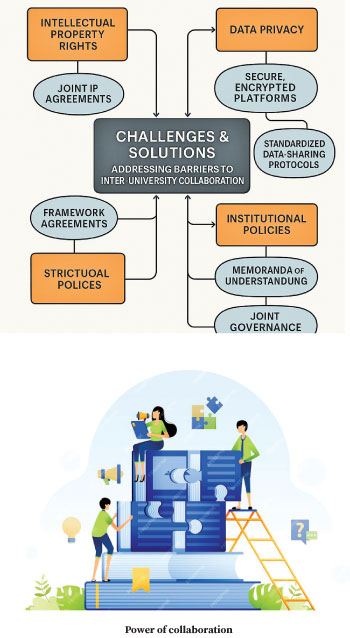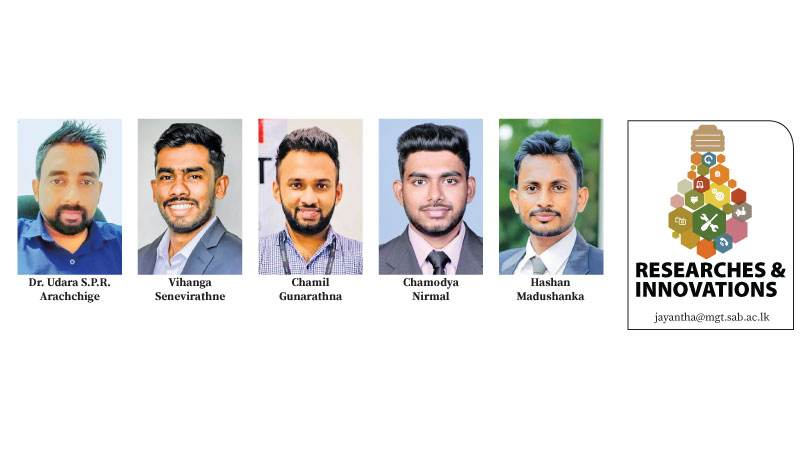In an era where scientific and technological advancements drive national progress, universities stand at the forefront of innovation. However, the full potential of academic research is often untapped due to limited resources, fragmented expertise, and isolated efforts. This is where inter-university technology sharing and collaboration play a transformative role—by pooling knowledge, infrastructure, and talent, institutions can accelerate groundbreaking research with real-world impact.
For a country like Sri Lanka, where research funding and advanced facilities are often constrained, such partnerships are even more crucial. By fostering collaboration between local and international universities, Sri Lanka can bridge gaps in technological capabilities, enhance research quality, and address pressing national challenges—from sustainable agriculture and renewable energy to healthcare and digital transformation. This article explores how shared technologies, joint research initiatives, and academic networks are unlocking new possibilities for Sri Lankan researchers, driving innovation, and positioning the nation as a competitive player in the global knowledge economy.
The power of collaboration
Sri Lanka has a wealth of innovative and high-calibre research potential, but it is frequently underutilized because of a lack of funding and dispersed academic endeavours. Strong collaborations between nearby universities have the potential to revolutionize the nation’s research environment. Universities can overcome individual constraints and more successfully address national challenges when they work together, sharing labs, knowledge, and research objectives. For instance, partnerships between NSBM Green University and research-intensive institutions—whether state-run or private—can open doors to collaborative supervision, skill development, and the implementation of transformative research initiatives.
 These partnerships would also aid in addressing the unequal access to specialized knowledge and cutting-edge equipment. Universities could create shared research centers, encourage interdisciplinary collaboration, and submit joint applications for national or international funding rather than replicating expensive infrastructure. Local adaptations can be made to the model established by global collaborations such as the Broad Institute or Horizon Europe. By providing funding and policy support, the Ministry of Education and University Grants Commission (UGC) can significantly contribute to encouraging inter-university research.
These partnerships would also aid in addressing the unequal access to specialized knowledge and cutting-edge equipment. Universities could create shared research centers, encourage interdisciplinary collaboration, and submit joint applications for national or international funding rather than replicating expensive infrastructure. Local adaptations can be made to the model established by global collaborations such as the Broad Institute or Horizon Europe. By providing funding and policy support, the Ministry of Education and University Grants Commission (UGC) can significantly contribute to encouraging inter-university research.
Additionally, promoting staff and student exchanges between universities can expand exposure and improve academic culture, which in turn promotes innovation across disciplines. Stronger publications, greater international recognition, and more significant community-focused solutions are frequently the results of collaborative research. Universities in Sri Lanka can improve their research output, spur regional innovations, and make significant contributions to the body of knowledge worldwide by dismantling organizational silos and fostering a culture of collaboration. In the long run, these collaborations will help Sri Lanka achieve its development objectives by providing indigenous, research-based solutions, in addition to enhancing its academic standing.
Resource optimization
Most of the Universities, long constrained by funding shortages and uneven infrastructure, are pioneering collaborative models to transform these challenges into opportunities. By prioritizing resource optimization, labs, and expertise institutions are proving that strategic collaboration can bridge gaps and amplify research impact.
Similarly, a centralized equipment-sharing system allows researchers across the country to access expensive, high-tech instruments without each institution needing to purchase them separately. For example, facilities could share advanced tools like:
= ICP-MS (Inductively Coupled Plasma Mass Spectrometry) for precise soil and material analysis,
= Spectrometers for measuring molecular concentration in solutions, and
= DNA sequencers for cutting-edge genetic research.
By implementing an efficient booking platform, universities can avoid costly duplicate purchases, saving millions in funding while ensuring these critical resources are fully utilized. This collaborative approach accelerates research progress and benefits the entire scientific community. UGC Collaborative Research Grants incentivize cross-institutional teams to merge niche skills. Urban computer scientists, for example, partner with agricultural researchers to develop AI-driven crop management tools, reducing reliance on costly consultants.
Similarly, shared nanotechnology labs for renewable energy research unite engineers and material scientists, minimizing the need for overseas training. While challenges like bureaucratic delays persist, these models exemplify how Sri Lanka’s academic sector is turning scarcity into collective strength. By institutionalizing shared labs, virtual platforms, and expertise networks, universities are ensuring cutting-edge research is no longer confined to well-funded institutions.
Success stories – international
International collaborations between top universities have played a pivotal role in accelerating scientific breakthroughs. The University of Oxford and AstraZeneca, in partnership with Imperial College London and other institutions, led the rapid development of a Covid-19 vaccine, showcasing how academic-industry synergy across borders can deliver life-saving solutions at scale.
In another example, the Massachusetts Institute of Technology (MIT) and Harvard University co-established the Broad Institute, which has become a global leader in genomics and biomedical research. This collaboration has produced transformative discoveries, including CRISPR gene-editing tools and cancer genomics datasets that are freely shared across the global research community.
The ETH Zurich and the National University of Singapore (NUS) have also partnered in sustainable urban development research. Their joint “Future Cities Laboratory” focuses on smart mobility, climate-resilient architecture, and energy-efficient urban infrastructure, directly influencing city planning in Asia and Europe. These international partnerships illustrate the unmatched value of shared expertise, diverse perspectives, and pooled resources in solving global challenges.
Challenges and solutions
There is no doubt that collaboration among universities can drive incredible breakthroughs but, it’s not always smooth sailing. Behind every triumph, teams often face numerous challenges like Intellectual Property (IP) rights, data privacy, and institutional red tape. The good news is, with the right approach, these barriers can become steppingstones for the success of the nation.
Regarding the IP issues, as an example, when universities join forces, conflicts often arise over who owns the resulting inventions, patents, research papers or whatever the outputs. Experts emphasize that early declaration of the ownership through joint agreements saves time and ensures the contribution made by everyone is recognized fairly.
Data privacy is another important challenge, especially in sensitive fields like healthcare or artificial intelligence. With strict rules such as Europe’s GDPR setting high standards, universities are adopting secure data-sharing platforms and anonymization techniques to protect privacy without hindering the collaboration. Then there’s the network of institutional bureaucracy from ethical approvals to procurement rules that can bog down even the noble-minded projects. Successful partnerships often rely on Memorandum of Understanding (MoUs) or joint committees to smooth the path and keep things on track.
At the heart of it all, one lesson stands out. Clear communication, smart planning, and a shared sense of purpose can turn barriers into groundbreaking innovations. By facing these challenges head-on, universities can build partnerships that accelerate innovation and deliver real-world impact.
Framework of inter-university collaboration: barriers, solutions, and outcomes
Ultimately, it is crucial for the government, the University Grants Commission, state and private universities, and research institutes to unite and take collective action for the greater good of our nation. Let us set aside personal agendas, move beyond institutional rivalries, and work together in true collaboration—because only through shared effort can we achieve meaningful progress for the people of Sri Lanka.
By:
Dr. Udara S.P.R. Arachchige, Mr. Chamil Gunarathna, Mr. Vihanga Senevirathne, Mr. Chamodya Nirmal, Mr. Hashan Madushanka , Faculty of Engineering, NSBM Green University, Sri Lanka









